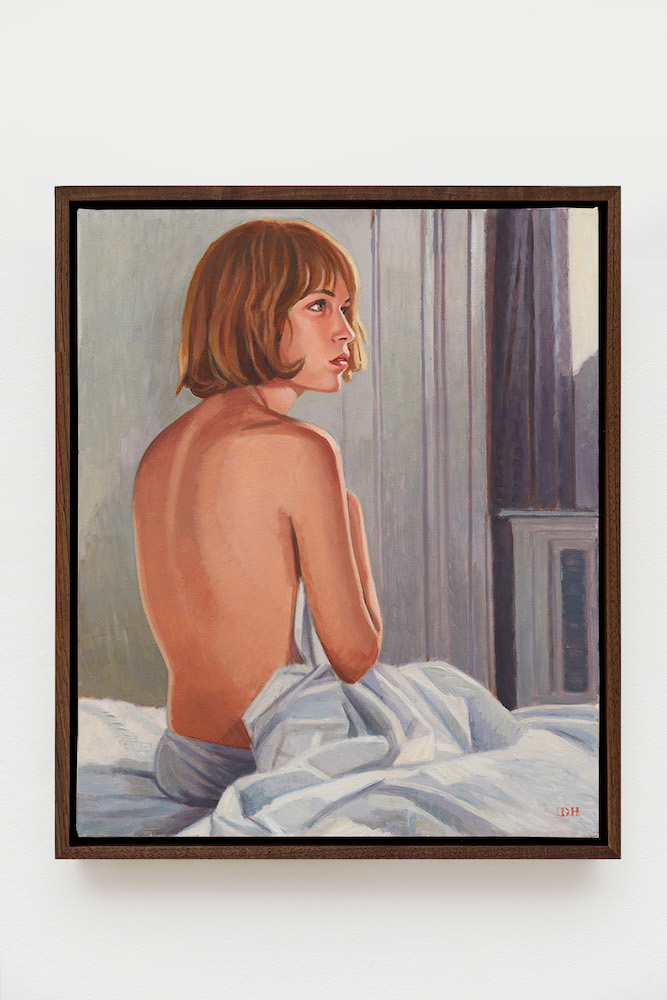In the early years of cinema, actors were treated as crew members working the conveyor belt of industrialized studio systems. But by the silent-film era of the 1910s, the star system had begun to take hold, with close-ups articulating a visual language of desire onscreen. Offscreen, studios deliberately cultivated actors’ personas, fueling a collective fixation on their bodies, faces, expressions and ways of being—a fixation that escalated in the 1930s and ’40s, and further from there. Enter Duncan Hannah, whose decades-spanning exhibition “Flesh and Fantasy” was on view at The Journal Gallery this fall. Emerging from the 1970s and ’80s New York art scene and cavorting with scene fixtures like Andy Warhol, Hannah developed his own distinctive, sometimes outré visual language, steeped primarily in nostalgia for midcentury golden-age and New Wave European auteur cinema. His pared-down oil paintings of modern and contemporary film stars, often set against monochromatic or plain backdrops, are contemplative, quiet, and unironic. Dozens of these portraits fill the gallery walls, alongside a few more narratively charged scenes — a train racing through a sweeping mountainous landscape in Alps (2020), a car perched cliffside in Thriller (n.d.) — that convey a cinematic quality of their own. The figures in Hannah’s paintings are not intimate portraits but representations of stardom itself, in which actors are hyper-visible yet necessarily distant.
Hannah positions his film stars in a liminal space between accessibility and inaccessibility—they are often partially turned away from the viewer or shown in various stages of undress. In Regarding Rosemary (2009), a woman sits on a bed, holding a sheet up to cover her breasts, while in Cinema Nuovo (2020), a woman stands in a dress shirt with no underpants on. Their body language makes plain the dual nature of stardom—celebrities are, by design, both symbols of glamour and objects of desire that are ultimately unattainable. Rather than focusing on the individual actresses themselves, Hannah’s work explores the aggregate effect of how we construct and engage with the actors we idolize, what scholar Richard Dyer has called “star texts.”
Much like how we might idly doodle stars (the celestial kind that glow at night) on scrap paper, Hannah paints human stars as though drifting in reverie. Strikingly, Hannah’s portraits of stars like Monica Vitti, Twiggy, Jean Seberg, and Sylvia Sidney express little fascination with the individual behind the image. We witness the stars stripped of most environmental contexts, sometimes appearing on minimally decorated film industry magazine covers. These compositions are imagined, as are some of the publications themselves. As such, they have a dreamlike lack of specificity and an absence of evident psychological complexity: Their faces are often blank, if distant or seductive. Take, for example, Anne Hathaway (2012). Hannah depicts Hathaway in three-quarters profile from the shoulders up against a green backdrop. Her eyes are relaxed and her lips are slightly parted, as though she were staring absently into the middle-distance. Such portraits are abundant across the exhibition, training visitors to reflect upon the act of looking itself rather than the identity of the star being regarded.
In contemporary celebrity culture, we are growing increasingly accustomed to seeing stars in purportedly raw, unguarded, and unromantic moments—tearful apologies on livestreams, posts with no makeup, proclamations of emotional distress. As the parasocial demand for authenticity and accessibility increases, Hannah’s portraits feel increasingly hagiographic, presenting his figures, even those still living, like saints from a storied past. This reverence feels refreshingly out of step with our own demystified, or differently mystified, view of fame, even as the underlying mechanisms of desire and fascination remain.


